Manfrotto 190XPROB
-
-
Written by Gordon Laing
Newer version available! See my Manfrotto MT190XPRO3 review!
The Manfrotto 190XPROB is a relatively compact and affordable tripod designed for general-purpose use. It’s one of the best-selling models in Manfrotto’s X range, striking a great balance between price and performance. Like most higher-end tripods, the 190XPROB does not come with a head as a standard. Instead it features a plate onto which you can mount a wide variety of optional heads to match your exact requirements.
In my full review of the 190XPROB I’ll compare its features and stability against three other key models in the same range, including the carbon fiber 190CXPRO3 version and the larger 055CXPRO3 and 055XPROB models. Together these four tripods dominate the sales charts as some of the best-selling models around, and for very good reason.
Manfrotto is one of the most respected names in the business and these tripods represent a significant step-up from budget options. Indeed after much research many photographers narrow their choices of a decent tripod down to these very four models, but then often struggle with their final decision. Ultimately which one will be best for you?
At Camera Labs we’ll help you make the right choice between these four popular models. We have separate reviews of each tripod, concentrating on what makes them different and explaining what kind of photography – and photographer – they’re designed for. Since all four models share a great deal in common, much of the text and results you’ll see here are duplicated across all four articles. But again, each review is presented from the viewpoint of one particular model, and on this page, it’s the turn of the 190XPROB – one of the most affordable models in the X range.
If you’re interested in the lighter carbon fiber version, check out our Manfrotto 190CXPRO3 review. If you’re looking for something taller and with greater load-handling, check out our Manfrotto 055XPROB review and Manfrotto 055CXPRO3 review. Note: Many thanks to Queenstown Cameras for the loan of an additional tripods during our tests. If you’re in Queenstown, New Zealand, and need any photographic equipment or prints, head on over to their store on Camp Street.
A brief history of Manfrotto
Today Manfrotto is one of the best-known and respected names in tripods, but how did it all begin, and why do some people know the products under the Bogen brand? The Manfrotto story starts in the late 1960s with Lino Manfrotto, a photo reporter based in Bassano del Grappa, Northern Italy. Manfrotto found much of the studio equipment of the day cumbersome and neglected to include basic stands and clamps. Spotting a gap in the market, Manfrotto produced a lighting stand, but only made a few units for friends.
In 1972, Manfrotto met Gilberto Battocchio, a mechanical engineer who helped him render his ideas and requirements into actual products, and in 1974, the first commercial Manfrotto tripod was launched. Over the next decade and a half the company grew significantly with manufacturing remaining in Italy. In 1989, the entire Lino Manfrotto shareholding was bought by the British Vitec group with Lino and Gilberto remaining in the Management team.
In 1992, the Vitec group bought the French high-end tripod company, Gitzo, followed by the American photographic distribution company Bogen a year later. The Bogen Imaging distribution network steadily grew until early 2010 when the name was changed to Manfrotto Distribution throughout all the countries it operated in.
Prior to this time, Manfrotto tripods were often sold under the Bogen name in certain regions – for example the 190XPROB and 055XPROB were commonly known as the Bogen 3001BPRO and 3021BPRO respectively in America. Today the same Manfrotto name and model numbers are now used worldwide, although both it and ‘rival’ Gitzo remain part of the same Vitec group.
Guide to Manfrotto’s X family
The 190XPROB is part of Manfrotto’s X family, designed for general-purpose use indoors and out. There are no fewer than 12 models in the current X family, divided equally between the 190 and 055 ranges. Fully understanding Manfrotto’s model numbers and knowing their capabilities is the key behind making the right choice; here’s a brief guide.
 | |
|---|---|
The 190 and 055 ranges are essentially identical other than their size and weight-handling. The 055 range is the bigger of the two, extending to taller heights and handling heavier camera systems, although this in turn also makes them bigger, heavier and more expensive. The 190 range are scaled-down versions which are smaller and lighter, but in turn handle less weight and don’t extend as high. It’s important to put this into perspective though – both ranges can easily handle most DSLRs and lenses, but those who have the heaviest cameras and biggest lenses will find the 055 range preferable. Taller people will also prefer the larger 055 range, although some may be willing to compromise on total height in order to have the physically smaller, lighter and cheaper 190 versions.
Within each range you have the choice of carbon fiber or aluminium models, labelled CX or X respectively. The carbon fiber ‘CX’ models are lighter and more rigid, but much pricier. The carbon fiber models are also available with three or four leg sections, the latter folding-down to a shorter length for transportation, but at the cost of slightly heavier weight, greater flex and slower setting-up; look for the numbers 3 or 4 at the end of the model name to indicate the numbers of leg sections. Models without a number at the end have the standard three sections.
Manfrotto 190XPROB | Manfrotto 055XPROB | Manfrotto 190CXPRO3 | ||
|---|---|---|---|---|
Manfrotto also offers the option of a centre column which can switch between vertical and horizontal operation quickly and without the need for disassembly. Models with this system have PRO in their names. At the other end of the scale are a pair of aluminium models which are unable to crouch as low as the others while also employing basic wing-nuts to lock their legs instead of the quicker push lever system; these cheaper models are designated with the letter D. When shopping for 190 and 055 tripods, you may also find other variations or those sold under the Bogen brand, but these are generally older models.
So the 190XPROB tripod reviewed here can be decoded as having the following specifications: it’s part of the smaller 190 range, with aluminium construction, the quick centre column adjustment, and three legs. Simple when you know what it all stands for.
Manfrotto 190XPROB leg design and build quality
The Manfrotto 190XPROB is a smart-looking tripod finished in black. The leg tubes and centre column are made of aluminium with a smooth finish. Aluminium is a traditional and familiar material used to construct tripods, so most photographers will know what to expect from the 190XPROB in terms of look, feel and weight. The reason we mention this though is because the alternative 190CXPRO3 version built from carbon fiber looks and feels quite different.
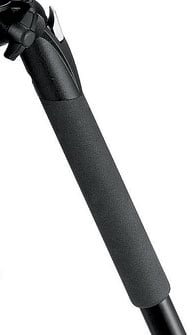 |
|---|
Manfrotto’s carbon fiber models employ a pull-winding manufacturing process said to maximise resistance and reliability. Upon closer inspection, the material and manufacturing process behind the carbon fiber tubes is evident by a series of thick diagonal lines which catch the light with organic-looking threads. It’s quite a different look to plain aluminium tubes, not to mention a different feel too.
The really important difference between carbon fiber and aluminium tripods though is their weight. The aluminium 190XPROB weighs 1.8Kg, compared to just 1.29Kg for the carbon fiber 190CXPRO3 version. That makes the carbon fiber model almost one third lighter and you really feel the difference the moment you pick them up, with the 190CXPRO3 feeling almost eerily light in comparison. Potential owners of the 190XPROB shouldn’t be too alarmed though, as its weight is actually quite manageable and feels well-balanced in your hands. This is unlike the surprising heft of the larger 055XPROB version which can quickly become a burden at a not inconsiderable 2.4Kg.
That said, if you’re mostly carrying your tripod by foot or bike, there’s no doubt the lighter carbon fiber models are preferred. The big surprise for many people though is to discover the carbon fiber versions are also actually more rigid, and this becomes apparent when comparing the 190XPROB and 190CXPRO3 side-by-side. Extend the legs on both to identical angles then push down on any part of the tripods, and you’ll find the aluminium version flexes more than the carbon fiber one. The carbon fiber version is simply stiffer, and in our tests below, was also measurably superior when it came to damping vibrations. A key advantage for carbon fiber.
A less obvious benefit of carbon fiber over aluminium is a surface which doesn’t become as cold in chilly temperatures. Anyone who shoots in cold conditions will know an aluminium tripod can become uncomfortable to carry and sticky to touch; indeed under extreme conditions you should avoid touching the metal surfaces at all with bare hands. To address this, Manfrotto has considerately fitted fabric leg warmers to the upper portions of two of the 190XPROB’s legs (pictured), which counteract the chills quite effectively, but for carbon fiber it’s simply not a problem as the material just doesn’t get that cold.
But for all the high-tech benefits of carbon fiber, there’s the simple fact a heavier tripod will enjoy a stability advantage under certain conditions, such as withstanding buffeting from wind. The 190XPROB is also considerably cheaper than the pricey carbon fiber version, so if you want a decent tripod at an affordable price and don’t mind (or would actually welcome) its weight, then this aluminium model will be preferred.
Manfrotto 190XPROB length and height
As explained above, the number 3 in the model name refers to three tube sections in each leg, which for the 190XPROB measure 25, 20 and 16mm in diameter; the tubes in the larger 055XPROB measure 29.4, 25 and 20mm in diameter. Each tube is locked firmly in position by levers which can quickly be pushed in our out. At no point during our testing did we experience the tubes slipping when locked.
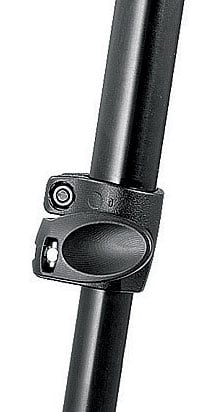 |
|---|
Like most aluminium tripods, the legs will extend under their own weight when unlocked, allowing you to be operational at full height within moments. Some will find this more convenient than carbon fiber tripods, which generally need to have their lighter legs extended (and pushed back again) by hand. Under extreme conditions, this may allow the aluminium 190XPROB to be fully extended or packed-away fractionally faster than the carbon fiber 190CXPRO3 version; those who operate in a hurry take note.
With the legs fully extended and set to their normal operating angle, the head plate is positioned 122cm from the ground. Extending the centre column takes the head plate to a maximum height of 146cm. Fold the legs and column down, and the minimum length for transportation becomes 57cm. The carbon fiber 190CXPRO3 version is almost identical in these regards, with the same maximum heights, but folding down to a fractionally longer 58cm.
Height is one of the major differences between the 190 and larger 055 series. The aluminium 055XPROB reaches 142cm with its legs extended alone, then goes on to tower over the 190s at 178.5cm with its centre column raised; this extra height comes at the price of a larger size when folded down though, with the 055XPROB measuring 65.5cm in length, while the wider tubes make for a thicker overall package. The carbon fiber 055CXPRO3 version is almost identical in these regards, measuring 65cm when folded down, 140cm with the legs extended, and 175cm with the centre column raised.
When calculating which height will be best for you, remember to also take into account the height of the head and the viewfinder or screen you’ll be using for composition – a typical Manfrotto head in landscape orientation would be about 10cm tall, while the viewfinder on an average DSLR is typically about 8cm from the base. So it’d be fair to add around 15 to 20cm to the tripod plate height to reach the viewfinder level of a typical DSLR.
Clearly if you’re tall, the extra foot or so of the 055 tripods will mean less stooping when composing, while shorter photographers will appreciate the stability of a tripod which simply doesn’t need to raise its centre column to meet their eye-level
But conversely the taller height of the 055 range makes them bigger to transport. The aluminium 190XPROB and carbon fiber 190CXPRO3 measure 57 and 58cm respectively when folded down – that’s up to 8cm shorter than their 055 counterparts. Their thinner legs and centre columns also make for a noticeably smaller package in total diameter, and one that’s much more easily accommodated in a bag. Indeed it’s quite dramatic how much space an 055 tripod consumes compared to a 190.
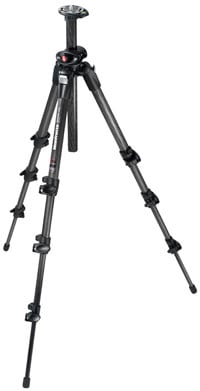 | |
|---|---|
Interestingly though, there may be a way to have your cake and eat it – at least with the pricier carbon fiber models anyway. Manfrotto offers alternative versions of the carbon fiber PRO 190 and 055 models with four leg sections instead of three. The maximum height of the four-legged 190CXPRO4 (pictured opposite) matches that of the 190CXPRO3, while the 055CXPRO4 only comes-up 5cm shorter than the 055CXPRO3 when fully extended. But fold them down, and the 190CXPRO4 and 055CXPRO4 measure just 50 and 54.6cm respectively, shaving 8 and 10.5cm from the length of their three-legged counterparts. That’s a pretty impressive saving, and even brings the four-legged 055 to a shorter folded length than the three-legged 190, again despite extending much higher and handling a bigger load; although of course any 055 model will remain much thicker than the 190s.
But before you sign-up for a four-legged tripod, there are a number of compromises to be aware of. Most importantly the more sections, the less rigid and stable the entire tripod will be. Each joint will flex, and the necessity to squeeze a fourth tube into the third means this final section will be very narrow; indeed on the 190 and 055 models, the fourth leg tubes measure just 11.6 and 16mm in diameter.
Secondly with nine locking latches compared to six, they’ll take a little longer to extend and fold away than three-legged versions, and of course there’s greater chance of mechanical failure. The four-legged versions are also slightly heavier and a little more expensive than their three-legged counterparts. So ultimately the four-legged 190CXPRO4 and 055CXPRO4 are only recommended for those who demand the features of the three-legged versions but simply can’t accommodate their length when folded-down.
Like most tripods, the 190XPROB’s legs can be set to different angles: in this case there’s four options at 25, 46, 66 and 88 degrees to the central column. Yes, that’s right, the fourth leg angle is virtually perpendicular to the centre column, allowing very low angles with a minimum height of just 8.5cm.
In this leg configuration, the central column needs to be raised to its maximum height, or more sensibly switched to the horizontal orientation (see below) to clear the ground, although you can also replace it for an optional shorter column if desired. Alternatively you could go for the less extreme 66 or 46 degree leg angles, reverse the column and hang the camera below the legs. There’s lots of options for low height configurations, giving the tripod a great deal of flexibility.
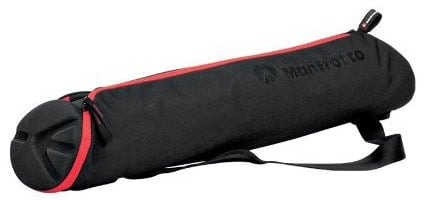 |
|---|
The tips of each leg are fitted with standard rubber feet, although optional spiked and suction feet are available. There are also mounting brackets for straps between the tops of the legs, but no carrying options supplied as standard.
Bags are an optional extra. Manfrotto’s MBAG70N (opposite) is ideal for carrying the 190XPROB with all but the biggest heads attached.
Manfrotto 190XPROB Centre column and head plate
The 190XPROB’s centre column is held in position by a large wing-nut which locks it securely when tightened. As a ‘PRO’ model, the 190XPROB features Manfrotto’s unique oval-shaped ‘Q90 degree’ section between the legs and top plate, which allows the centre column to be quickly reconfigured into a horizontal position. Horizontal configurations allow the camera to be mounted clear of the legs when shooting documents face-down, or for alternative macro positions – as mentioned above, it’s also handy when shooting with the legs out at their widest angle and the head very close to the ground.
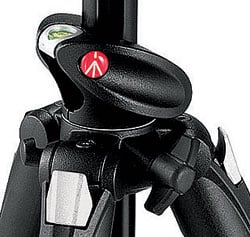 | |
|---|---|
To switch the column orientation on the 190XPROB and other PRO models, first untighten the column wing-nut, before extending the column to its maximum height. Then press the spring-loaded button in the end of the column – this lets you push the column up further still until it pops through the top of the legs and into the oval section. The column can then be lifted slightly further, allowing it to fall down 90 degrees into a horizontal position. It can then be pushed back through the oval section and locked as before using the wing-nut. Sounds complex written-down, but it’s easy in practice. To return it to the normal vertical orientation, simply loosen the wing-nut and slide the column to its maximum extension, before again pushing the button at the bottom to pop it through. You can then pull it out a little and raise it to its vertical angle, before finally pushing the column down to the desired height.
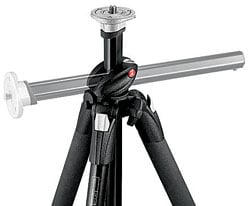 |
|---|
You’ll master the process in just a couple of attempts, after which the switch can be performed very quickly. With the wing-nut loosened, the oval section may rattle a little disconcertingly, but once tightened it feels rock-solid and we never experienced any issues with slippage while testing. Unfortunately the button at the bottom of the column prevents the fitting of a hook to hang weights for extra stability.
The entire centre column can also be removed and reversed for very low angles if desired, or swapped for an optional shorter version, allowing the legs to be fully widened without having the column extended.
All the PRO models offer built-in spirit levels: on the carbon fiber versions they’re integrated into the top plate, and on the aluminium ones they’re part of the lower Q90 section. Either way, they’re a handy addition whether the head you’re using is also equipped with one or not.
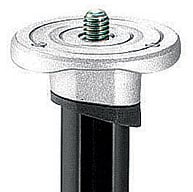 | |
|---|---|
All Manfrotto plates feature a standard 3/8in screw for mounting a choice of optional heads. These can be screwed on and off in a few seconds, and many photographers will own multiple heads for different applications. With a head screwed tightly onto the plate, it will normally stay fixed fairly securely, but if you’d like greater security, three small screws close to the edge of the plate can be mated with the head to hold it firmly in position.
As mentioned at the start, one of the major differences between the 190 and 055 ranges are the weights each can handle. The maximum load handling of any of the 190 models is 5Kg, compared to 7Kg on the aluminium 055XPROB and 8Kg on the carbon fiber 055CXPRO3 (and 4). That’s clearly a significant load benefit to the 055 range, but how much do you really need?
Given a typical head weighs between 0.5 and 1Kg (with only the heftiest models coming in any heavier), you can easily work out what you’ll have remaining for your camera and lens. Typical entry-level to mid-range DSLR bodies weigh between 500 and 700g with battery. Typical semi-pro DSLR bodies with battery (but no battery grip) generally weigh around 900g, while top-end pro DSLRs with built-in grips rarely weigh much more than 1.2Kg.
Each leaves a fair amount for a big lens. Basic kit lenses start at around 200g, while general-purpose or basic telephoto zooms are around 600g. A fast 70-200mm f2.8 lens may feel heavy, but will generally weigh around 1.5Kg. Even a 300mm f2.8 telephoto prime will work out about 2.5Kg. So technically speaking you could fit a 300mm f2.8 lens to a top-end pro DSLR, screw it to a half-decent head and still be within the load limit of a 190 tripod, so why would you need the extra capacity of the 055 range?
Beyond those who use larger format cameras or the biggest lenses, it really boils down to whether you want to operate close to or well within the limits of your equipment. A 190 tripod may not collapse under the weight of the configuration described above, but it will wobble much more than you’d like. Certainly if you do have higher-end bodies and large lenses, the 055 range will be much more suitable than the 190, but the latter will be more than sufficient for most body and lens combinations in general use. Even half the maximum load will accommodate some pretty high-end gear in a stable position. The bottom line is there may be a number of compelling reasons to choose the 055 range over the 190, but few should honestly reject the latter for inadequate load handling alone.
Manfrotto 190XPROB Real-life tests
One of the most revealing tests for a tripod is how quickly it can dampen vibrations. Even a gentle press of a button on a tripod-mounted camera can set it wobbling more than you’d think, especially with high magnification lenses. The time taken to dampen these vibrations is critical to avoid shake on self-timer shots activated by hand rather than cable-release, not to mention for your own sanity as you make adjustments to a composition.
Without building a dedicated rig to wobble or tap each tripod by the same amount every time, there’s no way to scientifically measure the exact damping capabilities of each model, but we devised a simple manual process which proved to be both revealing and sufficiently consistent for fair comparisons to be made. This involved simply giving the grip-side of the tripod-mounted camera a sharp tap by hand and timing how long it took for the vibrations to dissipate and become imperceptible on-screen at high magnification. This was repeated five times for each tripod configuration and the average time calculated to reduce variations in the taps. We also tested each tripod with their centre columns down and fully extended for comparison.
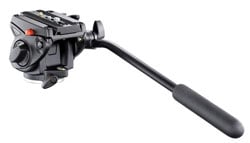 | |
|---|---|
The choice of head obviously also plays a significant role in the stability of the system as a whole. We chose the Manfrotto 701HDV head (pictured opposite) for our vibration tests, which uses a fork to support the camera plate on both sides rather than just one side on a traditional three-way model. It’s not Manfrotto’s sturdiest head by any means, but less prone to vibration than most models in general use.
As for timing the vibrations, we wanted a high magnification system with live view for making the observations, and a movie mode to record them for presentation here. We initially considered using a heavier semi-pro body, but ended-up selecting Canon’s mid-range EOS 550D / Rebel T2i for a number of reasons. First, a body of this size and weight represents the majority of DSLRs in common use. Secondly, it allowed us to exploit Canon’s Movie Crop mode which only records the central 640×480 pixels of the sensor, thereby cropping the image and multiplying the effective focal length of the system by 7.2 times. The resulting high magnification is a very demanding environment for any tripod, even when supporting a relatively light camera.
For the lens we once again opted for a popular focal length of 70-300mm, although due to availability the model used was the less common Canon EF 70-300mm DO. When fully zoomed-in and mounted on a cropped-frame body like the 550D / T2i, this lens delivered an effective focal length of 480mm. The Movie Crop function then effectively multiplied this by a further 7.2 times, delivering a final focal length equivalent to a massive 3456mm; in binocular or telescopic terms, that’s about 70x ‘normal’ (50mm) magnification. So while the total load itself was a fairly modest 1.25Kg (or just under 2.1Kg including the head), the chance to test each tripod at such a large and demanding effective focal length was one we felt had the overall edge. And once again while the Canon 550D / T2i isn’t a heavy body, it is representative of the DSLRs in most common use.
The target was an indoor flower arrangement at a distance of approximately 15m; with at an equivalent of 3456mm, little more than one flower head was visible in the frame. The location was inside the Queenstown Church we use for our standard low light camera tests; no-one else was in the building at the time and the tiled floor was absolutely steady. We timed the vibration dissipation on-location using the screen, but also recorded the results for presentation here.
We’ll be the first to admit it’s not the perfect tripod test, but as you’ll see, it still revealed some interesting and useful results.
Manfrotto 190XPROB Vibration results
You can see the effect of a single tap on each tripod configuration in our video below. Note the times quoted below and in the video are an average of five consecutive taps judged on-screen while performing the tests. The examples seen in the video may take more or less time to dissipate than the average time quoted, but still reveal the major differences between each model.
We started with the aluminium 190XPROB with its centre column down. In this configuration, the vibrations from a sharp tap were dampened in an average of 4.9 seconds. With the centre column raised, the vibrations took 7.4 seconds to visibly dissipate. It should come as no surprise to find a tripod becomes less stable with its centre column raised, but taking around 50% longer to dissipate vibrations from even a relatively light load is quite a performance-hit.
Moving onto the larger aluminium 055XPROB with the centre column down, the vibrations dissipated in an average of 3.2 seconds. That’s around 50% quicker than the 190 and clearly illustrates the superiority of this larger tripod, even with the relatively modest load. With the centre column raised though, we measured much the same time as the smaller model: an average of 7.1 seconds to dissipate the vibrations from the tap. So with the centre column raised, the larger aluminium 055 tripod had virtually no stability benefit over the 190 with our test load.
Next up we tried the carbon fiber models, starting with the smaller 190CXPRO3 with its centre column down. This time the vibrations dissipated in an average of just 1.7 seconds, around twice as fast as the aluminium 055 and roughly three times quicker than the aluminium 190. This is a very impressive result, and after testing the aluminium versions, it’s almost eerie to see how much quicker the carbon fiber models dissipate vibrations – you can see this in the video here. With the centre column raised, the vibrations took an average of 3.8 seconds to dissipate, just over twice as long as with the column down, but still quicker than the aluminium 190 and almost as fast as the aluminium 055 even with its column down.
Our final test was with the flagship carbon fiber 055CXPRO3, which with its centre column down took an average of 1.5 seconds to dissipate the vibrations from our sharp tap. Unsurprisingly this is the best result of the four models tested, but not significantly better than the smaller 190 version with our relatively modest load; you’ll need to mount much heavier loads to really see the benefit. But it’s still over twice as fast at dissipating vibrations as the aluminium 055 under the same conditions. With the centre column raised though, the vibrations actually took longer to dissipate than the carbon fiber 190, with an average of 4 seconds. So both the aluminium and carbon fiber 055s suffered from a bigger relative performance hit with their centre columns raised than the 190s did, although again both carbon fiber models significantly out-performed their aluminium counterparts in every configuration of this test.
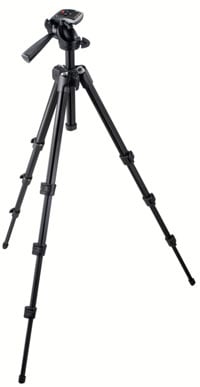 |
|---|
As a postscript, we also tested the ‘budget’ Manfrotto M-Y 7301 YB aluminium tripod which features a built-in head, pictured opposite. With the same load mounted and the centre column down, the tripod dissipated vibrations in an average of 4.3 seconds. With the column raised, the vibrations took 6.5 seconds to dissipate. You may be surprised to find these are actually superior to the times measured for the aluminium 190, but there’s much more to take into account as the 190 can extend both higher and much lower, handle much bigger loads, and of course has the flexibility of interchangeable heads. But it is still revealing to note in terms of dissipating vibrations, this affordable model isn’t at all bad.
The key messages we can take from these tests won’t come as much surprise: bigger and stronger tripods are less susceptible to wobbles than smaller ones; raising the centre column compromises stability; and carbon fiber can dissipate vibrations quicker than aluminium. But beyond verifying these facts, it’s the caveats and qualifications which are particularly interesting.
The bigger versions of the tripods may have been more stable than the smaller ones, but given an average load, the difference was actually very small. Raising the centre column unsurprisingly compromises stability, but probably by a lot more than you originally feared. And the difference between vibration dissipation on carbon fiber and aluminium models may be a lot more than you thought.
The actual numbers may also have you rethinking your technique, especially if you regularly trigger self-timers by hand and not cable release. While all vibrations with the columns raised or lowered were fully dissipated within a ten second countdown, most configurations were still wobbling well beyond two seconds.
So beware if you use a two-second countdown triggered by hand – if the centre column is raised, there’ll almost certainly be some motion remaining when the sensor is exposed. Of course fast shutter speeds not to mention shorter focal lengths will avoid most fine wobbles, but those using longer exposures or longer lenses could get caught out and perhaps blame their optics or image processing for a slightly soft image when it’s in fact the tripod and operator technique at fault.
Manfrotto 190XPROB Verdict
Each of the four tripods is designed for different requirements and budgets, and as such there’s no stand-out winner. It all depends on what you want from a tripod, and how much you’re willing to spend. What quickly becomes clear though is a justification for the broad number of options offered in the Manfrotto catalogue, and especially the four most popular models tested here: there’s little to no redundancy. So to answer the question posed at the start of this article, which of the four tripods is best for you?
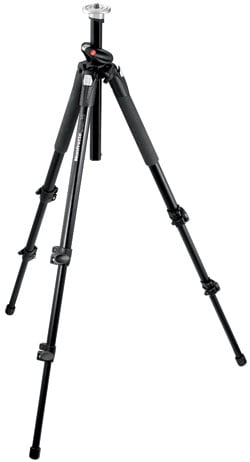 | |
|---|---|
We’ll get the simple decisions out of the way first, which essentially revolve around size and weight. If you’re tall and don’t want to stoop when composing, then go for one of the 055 models. Likewise if you want to mount particularly large and heavy cameras or lenses, the greater load-handling of the 055 range will be preferred.
Conversely if you want the most compact tripod for easy transportation, the smaller 190 range is preferable, and if weight is an issue, the carbon fiber models of either family are much lighter than their aluminium counterparts. This weight difference isn’t something you’ll need to go on a long hike to appreciate either – it’s obvious before you even step out the door. But carbon fiber doesn’t come cheap, so if budget is an issue, then go for an aluminium model.
Digging deeper, if you want a tripod which dissipates vibrations as quickly as possible, then the carbon fiber versions are again much preferred, although if you’re operating in strong winds, the heavier aluminium models may have the edge. If you shoot in very cold conditions, the carbon fiber models won’t become anywhere near as chilly to the touch, although leg warmers on the aluminium versions will equally make them easy to handle.
By now you’ll have a pretty good idea of which model will be best for you, but there are exceptions to consider. The 055 range for example may be designed for taller people and heavier loads, but there’s good reasons for shorter photographers with lighter systems to buy them. As our tests proved, there’s a significant difference in vibration dissipation with the centre columns down, and in this configuration, the height of the 055 range roughly matches the 190 with their columns extended. So if you need the height of the 190 range with the column extended, but want greater stability, the 055 will give you it with the column down. It’s this simple reason which will see the 055 selected by many photographers of average height. The 055 range also obviously has more room for growth – if not in height, then in camera system weight.
But conversely it’s important not to underestimate the strength and flexibility of the smaller 190 series, and the simple fact they’ll be good enough for most photographers. Certainly if you’re looking for a step-up from a budget tripod, one of Manfrotto’s 190 models will deliver significant benefits, and at a cheaper price than the 055s.
 |
|---|
As for the 190XPROB reviewed here, it’s hard not to be impressed with what you’re getting for the money. It may be the cheapest model of the four tested here, but still delivers a significant step-up from budget tripods. It’s relatively compact but extends to a height most would find acceptable, while handling sufficient load for the vast majority of photographers. Angle the legs out as far as they’ll go with the centre column horizontal and it’ll also crouch just a few inches above the ground.
It may not be as light as the carbon fiber 190CXPRO3, but unlike the hefty 055XPROB, its weight remains manageable and feels well-balanced in your hands. You may still need to be fairly committed to take it out on a long hike or bike ride, but unlike its larger aluminium counterpart, it rarely becomes a burden. Fold the legs down and it also becomes very manageable in size.
Like other models in the 190 range, the biggest issue facing the 190XPROB for many photographers will be its maximum height – it’s absolutely fine for people of short to medium height, but if you’re tall, you may find yourself crouching more than you’d like, and always relying on the centre column being raised, which as we saw in our tests, compromises stability. But then the taller 055XPROB will be eliminated by many on the grounds of size and weight, and while the weight issue is solved by the carbon fiber 055CXPRO3, it comes at a considerable price hike. As always, it’s a case of deciding which compromise best-fits your requirements and budget.
Ultimately, as proven by its consistently high position on the sales charts, many photographers looking for a decent tripod will settle on the 190XPROB. Again it may not be as light as the 190CXPRO3, nor as tall as the 055 models, but it does deliver great performance and flexibility for the money. It’s one of the best tripods at this price point.
If you found this review useful, please support me by shopping below!
Manfrotto 190XPROB | Manfrotto 055XPROB | Manfrotto 190CXPRO3 | ||
|---|---|---|---|---|



